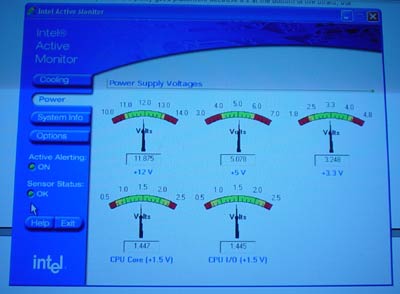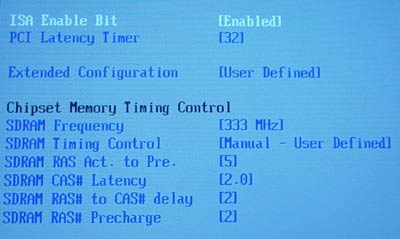Intel D845PEBT2 Blue Mountain 2 (845PE): Intel's Enthusiast Board
by Evan Lieb on October 10, 2002 2:30 AM EST- Posted in
- Motherboards
BIOS and Overclocking
We see that Intel uses their own BIOS for their 845PE-based D845PEBT2 motherboard.
Unfortunately, Intel didn't exactly expand their BIOS to include a great deal of options like we had hoped. You won't find any hardware monitoring (normally accessible through a "PC Health" menu) in the BIOS. However, Intel did include a software-level program called Intel Active Monitor.

Using this software you're able to view lots of different readings, including Vcore, CPU temperature, and PSU readings (all rails). There are also options for active alerting and setting sensor threshold levels. Another feature we found in Intel's Active Monitor was a "System Info" section, which is very similar to WCPUID. All in all, it's a nice piece of software to have, although many other Taiwanese motherboard makers have a similar type of hardware monitor software in addition to a BIOS hardware monitor.

One of the few tweaking options available in the D845PEBT2 BIOS is adjustable DRAM settings. Intel's "Chip Configuration" section (like Advanced Chipset Features section) allows you to tweak certain aspects of your memory; for example you can adjust CAS Latency, Precharge to Active, Active to Precharge, and Active to CMD. Too bad there aren't any options for Command Rate, Bank Interleave or Turbo mode (or something equivalent). These extra three DRAM options would have been helpful for our stress testing.

Intel doesn't change their stance on FSB adjustments either. There are no FSB tweaking options in the BIOS whatsoever. There were also no other software-level overclocking tools to be had, in addition to any other DRAM:CPU BIOS ratios. These features are standard on most any Taiwanese motherboard, but Intel seems to not want to even provide the possibility for tweaking or overclocking which diminishes the usefulness of the board as an "enthusiast" solution.
The same can be said of the voltage tweaking options. You can't adjust Vcore, VDIMM, AGP, or anything else in the D845PEBT2's BIOS. Again, these are the type of features that are standard with Taiwanese motherboards. It's also worthy of note that the D845PEBT2 consistently undervolted our 2.26GHz Pentium 4 to 1.44 - 1.45V Vcore.










13 Comments
View All Comments
aaronfinch - Monday, August 21, 2017 - link
https://www.appvalleyi.comhttps://www.appvalleyi.com/download-appvalley-vip-...
https://www.appvalleyi.com/download-appvalley-vip-...
aaditya - Sunday, November 19, 2017 - link
https://www.biggbosskannadaa.com/https://www.biggbosskannadaa.com/season-5-eliminat...
https://www.biggbosskannadaa.com/google-online-vot...
jamski - Tuesday, November 28, 2017 - link
https://wwe2k18download.com/https://wwe2k18download.com/wwe-2k18-apk-data-obb-...
ahmikinh4 - Wednesday, August 7, 2019 - link
<a href="https://www.nicoblogroms.com/mario-kart-wii-iso-do... rel="dofollow">mario kart</a> for get free gamesahmikinh4 - Wednesday, August 7, 2019 - link
https://www.revdlfree.com/ get apk gamesahmikinh4 - Wednesday, August 7, 2019 - link
https://freeapkpure.com/ nice postxahmikinh4 - Wednesday, August 7, 2019 - link
https://rexdl.info/ rexdl gamesahmikinh4 - Tuesday, August 4, 2020 - link
get pc games download from here https://oceantogames.comahmikinh4 - Tuesday, August 4, 2020 - link
download https://theemuparadise.com/ahmikinh4 - Tuesday, August 4, 2020 - link
wow https://bagas31.org/